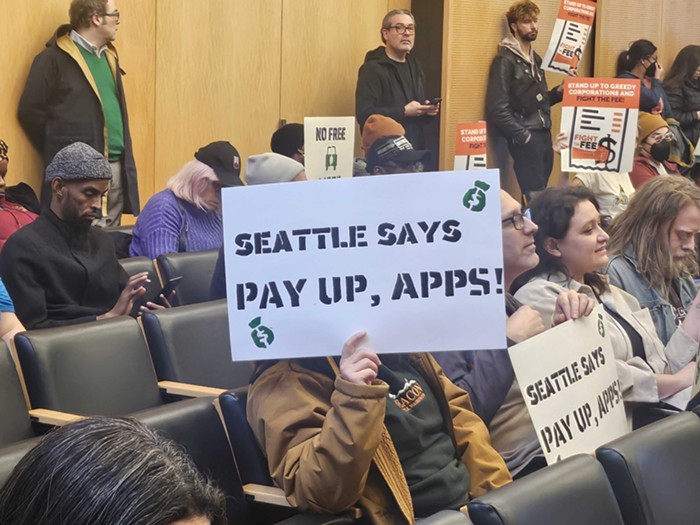
This week the Washington Department of Agriculture's team of entomologists cleared one nest of Asian giant hornets, aka "murder hornets," that infiltrated the state.
Murder hornets pose the biggest threat to sweet little honey bees. A group of murder hornets—what I imagine is something like a hornet special-ops team—can eviscerate a beehive in mere hours. That's bad because we need bees to do stuff like make honey and preserve entire ecosystems through pollination. To prevent the situation from turning into an infestation, human intervention this year was imperative. But tackling these hornets with regular beekeeper suits wasn't going to cut it.
To protect themselves while clearing nests, back in February WSDA's safety division team bought thick, foam suits—all white with some tasteful black detailing—from Amazon. The team selected these suits because of their thickness and breathability. Also, they only cost $170 each.
In case you want to be a Murder Hornet Entomologist for Halloween, you should know that a) the @WSDAgov team bought their suits off of Amazon "not knowing if they would work" (per @KUOW https://t.co/Y06KsObzk0) and b) I think these are the suits (https://t.co/TxawWn7En2) pic.twitter.com/MN4lRpsT02
— Hannah Weinberger (@Weinbergrrrrr) October 27, 2020
The suits make the entomologists look like extras in a low-rent 1960s space opera, or like they're wearing knock-offs of this atmospheric diving suit.
The Amazon suits only have one review: "Not a 'bee' suit. This is for dealing with yellowjackets when you do not have the option to destroy them but have to work around them. Or if you want to have a yellowjacket nest as a pet."
That review—five stars!—only references yellowjackets. Murder hornet stingers can grow up to 7 millimeters long, nearly double the length of a regular wasp stinger. Not only that, but the hornets pack more venom per sting than a normal wasp. These things kill roughly 50 people per year in Japan, according to the New York Times. The WSDA entomologists went into their hornet eradicating mission with no guarantee that the thick foam and mesh of the suits would block hornet stingers.
However, according to Wired, the suits are "a 20-millimeter-thick slab of foam sandwiched between an inner and outer coating of soft plastic mesh." The helmet has a battery-powered fan to keep air moving. They're high-tech, apocalyptic onesies. Still, the WSDA won't know if the suit is effective until someone is "attacked," Sven-Erik Spichiger, a managing entomologist at WSDA told me.
I wanted to gather some expert opinions on the Amazon suits. I don't know anything about insects. In fact, they repulse me. Not to discriminate, but six legs are too many legs. Anyway, I emailed some beekeepers. Bees are close to murder hornets, right? I mean, murder hornets take decapitated bee bodies back home for their young to eat. Same realm. Or at least they exist with each other in a predator-prey relationship.
Most beekeepers did not respond. I suspect they wanted to save me the trouble of reading through a litany of "I don't know anything about this" emails.
Mandy Shaw, a beekeeper from Portland, said she thought the suits looked like Stay Puft from Ghostbusters. She kindly pointed out that regular beekeepers don't use this shit, but that the thickness of the suit would be the most important part. She also specifically mentioned the multi-layered mesh face shield (which reminds me of the breathable liquid filling up a helmet in The Abyss). That face mask is primarily to defend against murder hornet spit. "They spit venom!" Shaw said. Oh. Right.
Jerry the Bee Guy, a Seattle beekeeper whose name is actually Marvin Johnson (I suspect this is a Dread Pirate Roberts situation but with beekeeping), also deals with wasps regularly. Wasps are like more aggressive hornets with less painful stings. He, too, mentioned the suit thickness and the venom-spit-preventing face shield. He also remarked on the WSDA's nest-clearing methodology, which he also uses in his practice. The entomologists used red lights to see when clearing the nests in the pre-dawn hours when the insects are less active, Johnson explained. Wasps and hornets are blind to red light.
Once entomologists approached the nest up in the reaches of an alder tree, the Seattle Times reported, they "stuffed dense foam padding" around the nest entrance, wrapped the tree in cellophane except for one entry point, and stuck a vacuum into that hole. Slurp. Up went 85 murder hornets. The team pumped carbon dioxide into the tree to take care of any remaining hornets.
Johnson did have one criticism about the suits.
"The black tape and contrasts seem lame to me," Jerry the Bee Guy, aka Marvin Johnson said. "The dark color I find is something that sets off wasps."
While red doesn't arouse wasps and hornets, dark colors will make them go on the defensive.
Johnson explained how he usually deals with wasps. "I cover my black veil with a white mesh bag and feel much less harassed by wasps."
Despite the dark colors on the suits, the WSDA entomologists cleared the first murder hornet nest in Whatcom County this week without issue or injury. Then where's the five-star Amazon review from the WSDA?
I'm not sure the WSDA will be making one.
"They are fairly uncomfortable and run a bit small," Spichiger said. "For most of us, the suit restricts arm movement and vision and is tight around the shoulders. The headpiece tends to press against your face, and, in my case, the boots are too tight even though I am using the largest size."
To be fair, adding a "runs small, size up" note in the reviews could be helpful. Or maybe, "not for the claustrophobic." However, the WSDA did tell Wired that no one needs to buy their own murder hornet protective gear.



















